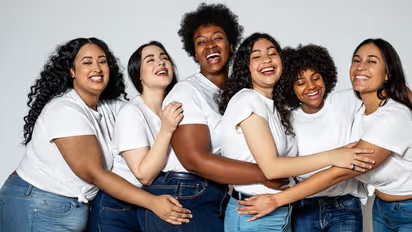Move over waist-to-hip ratio! Scientists reveal what really an 'ideal' woman's body looks like

Synopsis
A new study claims to have discovered the formula for the perfect woman's body - and it isn't about the waist-to-hip ratio as many had assumed.
For centuries, the idea of a 'perfect female body' has been intricately tied to the waist-to-hip ratio, but a groundbreaking research is now challenging this age-old belief. Scientists from the University of Konstanz have found that the ultimate marker of attractiveness may not lie in a slim waist or precise body measurements, but rather in an elegant ‘S’ curve that stretches from chest to thighs. This provides new insights into why icons like Marilyn Monroe and Kim Kardashian have long captivated public admiration with their curves.
The study overturns older research which assumed that a waist-to-hip ratio of 0.7 was the ideal body shape for a woman.
"Theoretical considerations suggest that the waist-to-hip ratio (WHR) cannot serve as a valid indicator of curviness, contrary to what is frequently assumed, either implicitly or explicitly," the researchers argue. "The results of this study clearly show that curviness is far superior to the WHR in this respect."
According to Daily Mail, Professor Ronald Hubner, the study's lead author, sought to put this theory to the test by presenting 80 participants with carefully crafted line drawings of various female body shapes. Initial findings confirmed that the idealized 0.7 ratio indeed appealed to participants in normal-weight body types, earning an attractiveness score of 74 on a 100-point scale. However, when larger bodies were introduced, waist-to-hip ratios lost their predictive power, with curviness emerging as a more reliable indicator of appeal.
In a follow-up experiment, Hubner's team showcased torsos with exaggerated curves reminiscent of tightly corseted figures, allowing for an isolated assessment of curviness. With 98 male and female participants rating these images, it became clear: curvier shapes consistently topped the charts, scoring as high as 100, regardless of their waist-to-hip proportions.
For wider body types, a more dramatic curve emerged as the most attractive feature, while smaller-waisted shapes scored only 17 at the same width.
Why this evolution toward curves?
Scientists suggest that such shapes may signal reproductive fitness, playing a role in mate selection over thousands of years. Wider hips and curves indicate an enhanced ability to carry and nurture children, potentially explaining why humans may be instinctively drawn to this body type.
“Body width not only indicates the amount of fat around the hips but also the pelvic width, which is important for successful birthing,” explains Professor Hubner.
Check the Breaking News Today and Latest News from across India and around the world. Stay updated with the latest World News and global developments from politics to economy and current affairs. Get in-depth coverage of China News, Europe News, Pakistan News, and South Asia News, along with top headlines from the UK and US. Follow expert analysis, international trends, and breaking updates from around the globe. Download the Asianet News Official App from the Android Play Store and iPhone App Store for accurate and timely news updates anytime, anywhere.